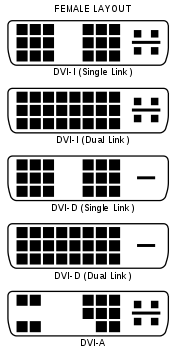
 |
|
|||||||
| Hardware Support Discussions related to using various hardware setups with SageTV products. Anything relating to capture cards, remotes, infrared receivers/transmitters, system compatibility or other hardware related problems or suggestions should be posted here. |
 |
|
|
Thread Tools | Search this Thread | Display Modes |
|
#1
|
|||
|
|||
|
New Video Card - New TV
Just purchased a new video card, figured a new TV REQUIRED a new card .
 Anyhow, the new card has two, dual link DVI connectors. I have a single link DVI to HDMI cable. Is the major difference between single and dual link bandwidth ? As the HTPC is running at 1920 x 1080, which is the upper limit for single link, no problem ? Anyhow, the new card has two, dual link DVI connectors. I have a single link DVI to HDMI cable. Is the major difference between single and dual link bandwidth ? As the HTPC is running at 1920 x 1080, which is the upper limit for single link, no problem ?And, if needed, where's a good site to get a dual link DVI to HDMI cable at less than BB prices ? |
|
#2
|
|||
|
|||
|
Plagiarized content from a google search:
Quote:
Quote:
|
|
#3
|
||||
|
||||
|
Doesn't matter, odds are your TV isn't dual-link anyway.
If you want a cable, monoprice.com is the place to go. |
|
#4
|
||||
|
||||
|
From http://www.datapro.net/techinfo/dvi_info.html
Quote:
__________________
Server: Core 2 Duo E4200 2 GB RAM, nVidia 6200LE, 480 GB in pool, 500GB WHS backup drive, 1x750 GB & 1x1TB Sage drives, Hauppage HVR-1600, HD PVR, Windows Home Server SP2 Media center: 46" Samsung DLP, HD-100 extender. Gaming: Intel Core2 Duo E7300, 4GB RAM, ATI HD3870, Intel X-25M G2 80GB SSD, 200 & 120 GB HDD, 23" Dell LCD, Windows 7 Home Premium. Laptop: HP dm3z, AMD (1.6 GHz) 4 GB RAM, 60 GB OCZ SSD, AMD HD3200 graphics, 13.3" widescreen LCD, Windows 7 x64/Sage placeshifter. |
|
#5
|
||||
|
||||
|
yeah, apple had to get a video card made with dual-link DVI when they first introduced their 30" LCD monitor (2560 x 1600) they actually shipped the card with two dual-link DVI ports to support 2x30" monitors.
I think televisions will be stuck at 1920x1080 for quite a while, though as 120 mhz refresh rates grow more common on televisions, bandwith may become more of an issue (though HDMI 1.3 is supposed to address this already - due to the extra bandwidth needed for lossless surround sound on Blu-ray and HD DVD.)
__________________
MacBook Core2Duo 2 ghz nVidia 9400M GPU 46" Sammy HLP4663 720p DLP 2x HDHR, all OTA QNAP TS-809: 12.5 TB for Recordings/Imports/TimeMachine/Music HD200 via 802.11n in Living Room 802.11n client in bedroom |
|
#6
|
|||
|
|||
|
Wikipedia is there for those who need pictures to follow along.
Digital Visual Interface   Here are some of the possible resolutions from the specifications: Quote:
Last edited by Conejo; 10-28-2007 at 08:39 PM. Reason: added links |
|
#7
|
|||
|
|||
|
Thanks, guys. Interesting, the connectors on the video card look like the DVI-I dual link so it may support the higher bandwidths. The TV only goes to 1920 x 1080 progressive. Hopefully, in a year or so, when this TV gets shunted to the bedroom and a new, super-size TV shows up in the family room, the higher bandwidth will be useful.
|
|
#8
|
|||
|
|||
|
Quote:
|
|
#9
|
|||
|
|||
|
Finally got the new video card installed and hooked up to the new TV via DVI - HDMI. And, it looks pretty good. This is the closest its ever been to the direct cable PQ. In some cases, it almost looks better. The WF has also increased, although she still won't touch the Harmony 676 remote.
Anyhow, IMO, the digital connection, single link DVI to HDMI, running at 1920 x 1080, 60 Hz, progressive, yields better PQ then analog component. Also, there is a new version of HDMI coming out ? Uses 23 contacts rather than 19 ? When will it end ??  If you are using an ATI AGP video card, use the 7.7 driver. Later versions have problems with AGP cards. Ain't it great ... Last edited by Ken C; 11-03-2007 at 11:44 AM. |
 |
| Currently Active Users Viewing This Thread: 1 (0 members and 1 guests) | |
|
|
 Similar Threads
Similar Threads
|
||||
| Thread | Thread Starter | Forum | Replies | Last Post |
| SageTV V6.1.7 Release Candidate | Narflex | SageTV Beta Test Software | 1 | 04-05-2007 12:26 PM |
| New video card = VMR9 doesn't look so good | davin | SageTV Software | 7 | 03-07-2007 07:20 PM |
| Video pixelization, lockups, BSODs, etc. Help! | brianblank | Hardware Support | 5 | 01-31-2007 10:45 PM |
| Video Card Info | mike_15 | Hardware Support | 0 | 01-16-2007 07:22 PM |
| Component Out Video card | dpackham | Hardware Support | 3 | 12-30-2006 12:36 PM |